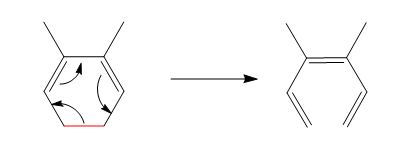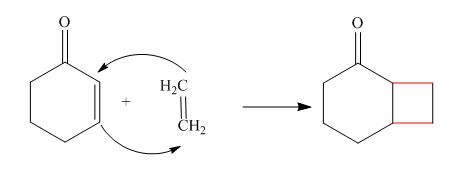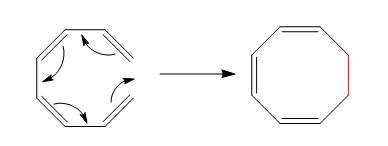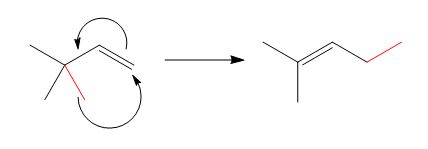
Concept explainers
(a)
Interpretation: The given reaction is to be classified as an electrocyclic reaction, cycloaddition, or a sigmatropic rearrangement. The sigma bonds that are broken or formed in the given reaction are to be labeled.
Concept introduction: A
Answer to Problem 27.1P
The reaction is classified as an electrocyclic reaction. The sigma bond broken or formed in the given reaction is,

Explanation of Solution
The given reaction is shown below.

Figure 1
The sigma bond that is broken during the conversion of reactant into product is shown in red. The new bonds formed during the conversion are shown by curved arrows in the reactant. In the product, the ring is opened due to the rearrangement of
The reaction is classified as an electrocyclic reaction. The sigma bond that is broken or formed in the given reaction is labeled in Figure 1.
(b)
Interpretation: The given reaction is to be classified as an electrocyclic reaction, cycloaddition, or a sigmatropic rearrangement. The sigma bonds that are broken or formed in the given reaction are to be labeled.
Concept introduction: A chemical reaction that involves
Answer to Problem 27.1P
The reaction is classified as a cycloaddition reaction. The sigma bonds broken or formed in the given reaction are,

Explanation of Solution
The given reaction is shown below.

Figure 2
The sigma bonds that are formed during the conversion of reactant into a product are shown in red. In the reaction,
The reaction is classified as a cycloaddition reaction. The sigma bonds broken or formed in the given reaction are labeled in Figure 2.
(c)
Interpretation: The given reaction is to be classified as an electrocyclic reaction, cycloaddition, or a sigmatropic rearrangement. The sigma bonds that are broken or formed in the given reaction are to be labeled.
Concept introduction: A chemical reaction that involves
Answer to Problem 27.1P
The reaction is classified as an electrocyclic reaction. The sigma bond broken or formed in the given reaction is,

Explanation of Solution
The given reaction is shown below.

Figure 3
The sigma bond that is formed during the conversion of reactant into product is shown in red. The new bonds formed during the conversion are shown by curved arrows in the reactant. In the product, the ring gets closed due to the rearrangement of
The reaction is classified as an electrocyclic reaction. The sigma bond broken or formed in the given reaction is labeled in Figure 3.
(d)
Interpretation: The given reaction is to be classified as an electrocyclic reaction, cycloaddition, or a sigmatropic rearrangement. The sigma bonds that are broken or formed in the given reaction are to be labeled.
Concept introduction: A chemical reaction that involves
Answer to Problem 27.1P
The reaction is classified as a sigmatropic reaction. The sigma bonds broken or formed in the given reaction are,

Explanation of Solution
The given reaction is shown below.

Figure 4
The sigma bond that is broken and formed during the conversion of reactant into product is shown in red. The product indicates that
The reaction is classified as a sigmatropic reaction. The sigma bonds broken or formed in the given reaction are labeled in Figure 4.
Want to see more full solutions like this?
Chapter 27 Solutions
Organic Chemistry-Package(Custom)
- Synthesize 2-Ethyl-3-methyloxirane from dimethyl(propyl)sulfonium iodide using the necessary organic or inorganic reagents. Draw the structures of the compounds.arrow_forwardSynthesize 2-Hydroxy-2-phenylacetonitrile from phenylmethanol using the necessary organic or inorganic reagents. Draw the structures of the compounds.arrow_forwardSynthesize N-Methylcyclohexylamine from cyclohexanol using the necessary organic or inorganic reagents. Draw the structures of the compounds.arrow_forward
- Synthesize N-Methylcyclohexylamine from cyclohexanol using the necessary organic or inorganic reagents. Draw the structures of the compounds.arrow_forwardIf possible, please provide the formula of the compound 3,3-dimethylbut-2-enal.arrow_forwardSynthesize 1,4-dibromobenzene from acetanilide (N-phenylacetamide) using the necessary organic or inorganic reagents. Draw the structures of the compounds.arrow_forward
- Indicate the products obtained by mixing (3-oxo-3-phenylpropyl)triphenylphosphonium bromide with sodium hydride.arrow_forwardWe mix N-ethyl-2-hexanamine with excess methyl iodide and followed by heating with aqueous Ag2O. Indicate the major products obtained.arrow_forwardIndicate the products obtained by mixing acetophenone with iodine and NaOH.arrow_forward
- Indicate the products obtained by mixing 2-Propanone and ethyllithium and performing a subsequent acid hydrolysis.arrow_forwardIndicate the products obtained if (E)-2-butenal and 3-oxo-butanenitrile are mixed with sodium ethoxide in ethanol.arrow_forwardQuestion 3 (4 points), Draw a full arrow-pushing mechanism for the following reaction Please draw all structures clearly. Note that this intramolecular cyclization is analogous to the mechanism for halohydrin formation. COH Br + HBr Brarrow_forward
 ChemistryChemistryISBN:9781305957404Author:Steven S. Zumdahl, Susan A. Zumdahl, Donald J. DeCostePublisher:Cengage Learning
ChemistryChemistryISBN:9781305957404Author:Steven S. Zumdahl, Susan A. Zumdahl, Donald J. DeCostePublisher:Cengage Learning ChemistryChemistryISBN:9781259911156Author:Raymond Chang Dr., Jason Overby ProfessorPublisher:McGraw-Hill Education
ChemistryChemistryISBN:9781259911156Author:Raymond Chang Dr., Jason Overby ProfessorPublisher:McGraw-Hill Education Principles of Instrumental AnalysisChemistryISBN:9781305577213Author:Douglas A. Skoog, F. James Holler, Stanley R. CrouchPublisher:Cengage Learning
Principles of Instrumental AnalysisChemistryISBN:9781305577213Author:Douglas A. Skoog, F. James Holler, Stanley R. CrouchPublisher:Cengage Learning Organic ChemistryChemistryISBN:9780078021558Author:Janice Gorzynski Smith Dr.Publisher:McGraw-Hill Education
Organic ChemistryChemistryISBN:9780078021558Author:Janice Gorzynski Smith Dr.Publisher:McGraw-Hill Education Chemistry: Principles and ReactionsChemistryISBN:9781305079373Author:William L. Masterton, Cecile N. HurleyPublisher:Cengage Learning
Chemistry: Principles and ReactionsChemistryISBN:9781305079373Author:William L. Masterton, Cecile N. HurleyPublisher:Cengage Learning Elementary Principles of Chemical Processes, Bind...ChemistryISBN:9781118431221Author:Richard M. Felder, Ronald W. Rousseau, Lisa G. BullardPublisher:WILEY
Elementary Principles of Chemical Processes, Bind...ChemistryISBN:9781118431221Author:Richard M. Felder, Ronald W. Rousseau, Lisa G. BullardPublisher:WILEY





